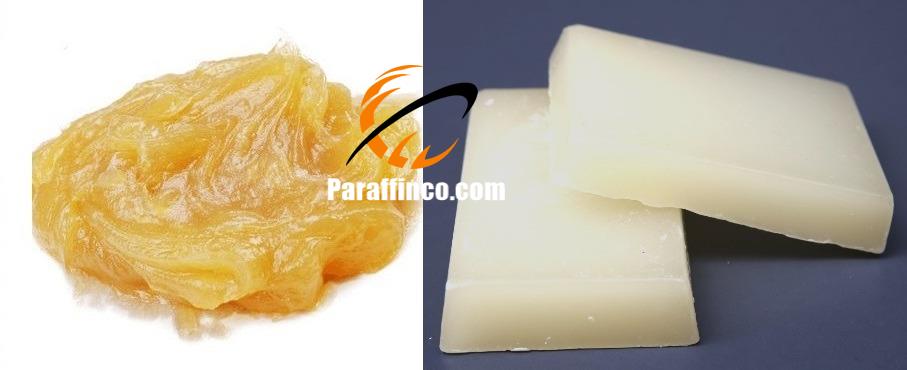Exploring the Differences: Residue Wax vs Slack Wax
Residue Wax Vs. Slack Wax, In the world of wax products, Residue Wax and Slack Wax stand out as two distinct substances with unique characteristics and versatile applications. While both originate from petroleum refining processes, they undergo different treatments and possess varying properties that make them suitable for a wide range of industrial and commercial uses. This comprehensive guide aims to delve deep into the world of Residue Wax and Slack Wax, exploring their differences, similarities, and diverse applications across various industries. (Applications of Slack Wax: Cosmetics and Personal Care, Polishes and Coatings, Paper and Packaging) (Applications of Residue Wax: Rubber Manufacturing, Candle Making, Waterproofing Treatments)
What is Residue Wax?
Residue Wax, also known as Foots Oil, is a byproduct derived from the refining of crude petroleum wax. It consists of impurities, solid wax particles, and residual oil content removed during the purification process. Residue Wax is typically dark in color and has a high melting point.
Key Characteristics of Residue Wax
-
Composition
Residue Wax contains solid wax particles and residual oil content, giving it a semi-solid consistency.
-
Color and Appearance
It is dark in color and may contain impurities that affect its appearance and texture.
-
High Melting Point
Residue Wax has a relatively high melting point, making it suitable for applications requiring thermal stability and resistance to heat.
Applications of Residue Wax
-
Rubber Manufacturing
Residue Wax is used as a lubricant and release agent in the vulcanization process of rubber compounds, preventing sticking and facilitating Mold release.
-
Candle Making
It serves as a cost-effective ingredient in candle wax formulations, providing hardness and structure to candles.
-
Waterproofing Treatments
Residue Wax is applied to fabrics, leather, and paper products to impart water repellence and moisture resistance.
What is Slack Wax?
Slack Wax is a semi-refined petroleum wax obtained from the solvent dewaxing process during crude oil refining. It contains a mixture of saturated hydrocarbons, solid wax crystals, and residual oil content. Slack Wax is typically lighter in color compared to Residue Wax and has a lower melting point.
Key Characteristics of Slack Wax
-
Purity
Slack Wax undergoes a semi-refining process to remove impurities and colorants, resulting in a higher degree of purity compared to Residue Wax.
-
Color and Appearance
It is lighter in color and has a translucent appearance, indicating a lower level of impurities.
-
Lower Melting Point
Slack Wax has a lower melting point compared to Residue Wax, making it more suitable for applications requiring lower viscosity and easier processing.
Applications of Slack Wax
-
Cosmetics and Personal Care
Slack Wax is used in the formulation of creams, lotions, and lip balms as an emollient and thickening agent.
-
Polishes and Coatings
It serves as a key ingredient in furniture polishes, shoe polishes, and wax coatings due to its glossy finish and protective properties.
-
Paper and Packaging
Slack Wax is applied to paper products and packaging materials to provide moisture resistance and improve surface gloss.
Differences and Similarities
- Composition: Residue Wax contains solid wax particles and residual oil content, while Slack Wax consists of saturated hydrocarbons and solid wax crystals.
- Color and Appearance: Residue Wax is darker in color and may contain impurities, whereas Slack Wax is lighter in color and has a more translucent appearance.
- Melting Point: Residue Wax has a higher melting point compared to Slack Wax, making it suitable for applications requiring higher thermal stability.
- Applications: While both Residue Wax and Slack Wax find applications in various industries, their specific uses may differ based on their properties and characteristics.
Choosing the Right Wax for Your Needs according to the Project Requirement
- For applications requiring higher thermal stability and water resistance, Residue Wax may be the preferred choice.
- For applications requiring lower viscosity and ease of processing, Slack Wax may offer better performance and suitability.
Conclusion
Residue Wax Vs. Slack Wax, In conclusion, Residue Wax and Slack Wax are two distinct wax products with unique properties and applications. Understanding their differences and similarities is essential for selecting the right wax for specific industrial, commercial, or personal care needs. By harnessing the diverse properties of Residue Wax and Slack Wax, industries and individuals alike can benefit from their versatility and reliability in various applications.
Through this comprehensive guide, we have explored the differences, similarities, and applications of Residue Wax and Slack Wax. Whether you’re a manufacturer crafting candles, a cosmetics formulator creating skincare products, or a packaging company seeking moisture-resistant coatings, understanding these two wax products empowers you to make informed decisions and achieve optimal results in your endeavors.
(Applications of Slack Wax: Cosmetics and Personal Care, Polishes and Coatings, Paper and Packaging) (Applications of Residue Wax: Rubber Manufacturing, Candle Making, Waterproofing Treatments)
If You have any other Query or Question you want to ask, Please don’t hesitate to Contact Us

